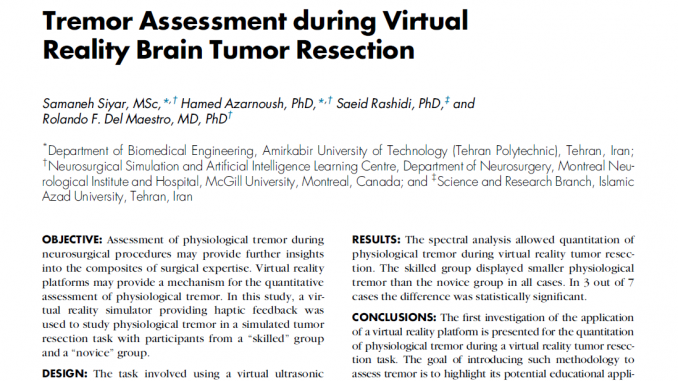
Samaneh Siyar MSc*†, HamedAzarnoush PhD*†, Saeid Rashidi PhD‡, Rolando F. Del Maestro MD, PhD†
Journal of Surgical Education
https://doi.org/10.1016/j.jsurg.2019.11.011
Objective
Assessment of physiological tremor during neurosurgical procedures may provide further insights into the composites of surgical expertise. Virtual reality platforms may provide a mechanism for the quantitative assessment of physiological tremor. In this study, a virtual reality simulator providing haptic feedback was used to study physiological tremor in a simulated tumor resection task with participants from a “skilled” group and a “novice” group.
Design
The task involved using a virtual ultrasonic aspirator to remove a series of virtual brain tumors with different visual and tactile characteristics without causing injury to surrounding tissue. Power spectral density analysis was employed to quantitate hand tremor during tumor resection. Statistical t test was used to determine tremor differences between the skilled and novice groups obtained from the instrument tip x, y, z coordinates, the instrument roll, pitch, yaw angles, and the instrument haptic force applied during tumor resection.
Setting
The study was conducted at the Neurosurgical Simulation and Artificial Intelligence Learning Centre, Montreal Neurological Institute and Hospital, McGill University, Montreal, Canada.
Participants
The skilled group comprised 23 neurosurgeons and senior residents and the novice group comprised 92 junior residents and medical students.
Results
The spectral analysis allowed quantitation of physiological tremor during virtual reality tumor resection. The skilled group displayed smaller physiological tremor than the novice group in all cases. In 3 out of 7 cases the difference was statistically significant.
Conclusions
The first investigation of the application of a virtual reality platform is presented for the quantitation of physiological tremor during a virtual reality tumor resection task. The goal of introducing such methodology to assess tremor is to highlight its potential educational application in neurosurgical resident training and in helping to further define the psychomotor skill set of surgeons.
KEY WORDS physiological tremor, neurosurgery, NeuroTouch/Neuro, VR simulation, virtual reality, tumor resection
Competencies Patient Care, Practice-Based Learning and Improvement, Systems-Based Practice
